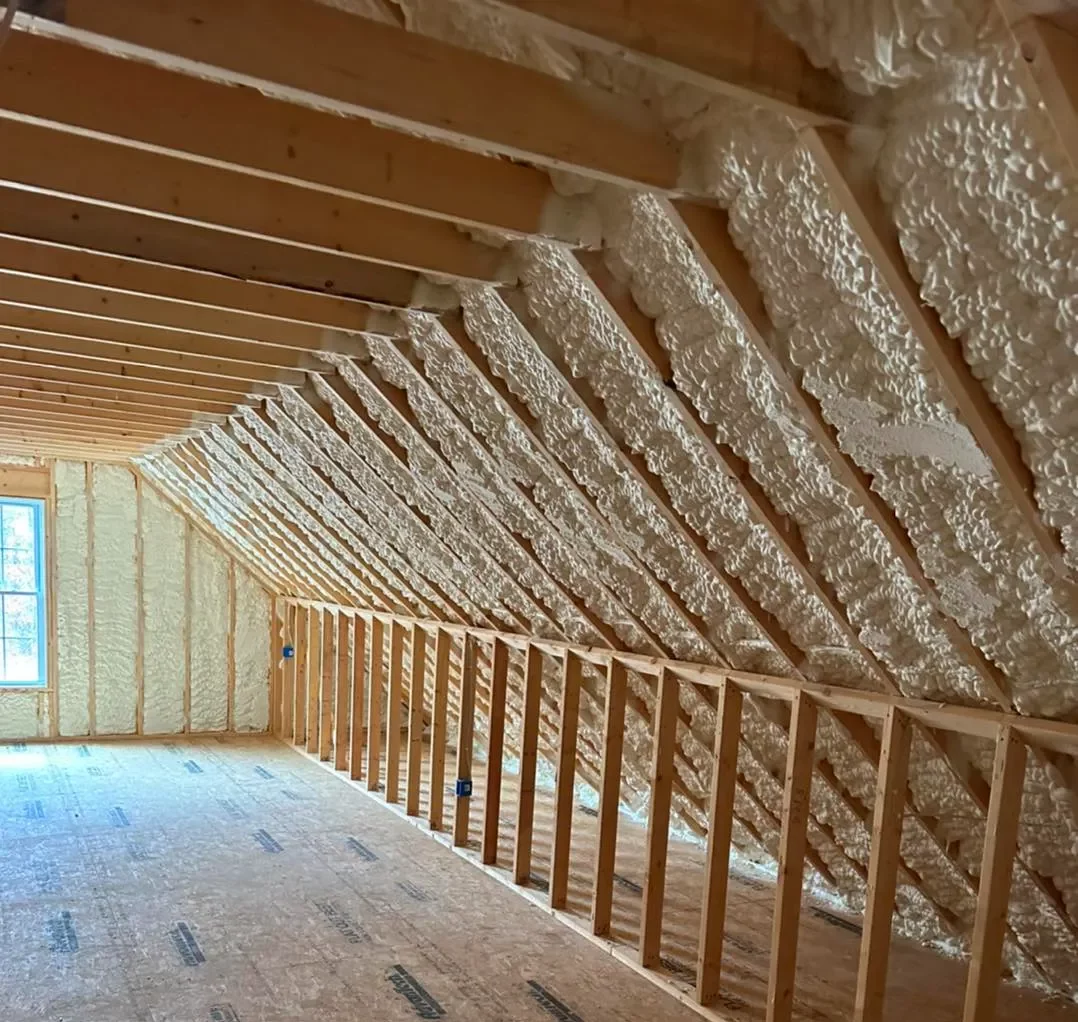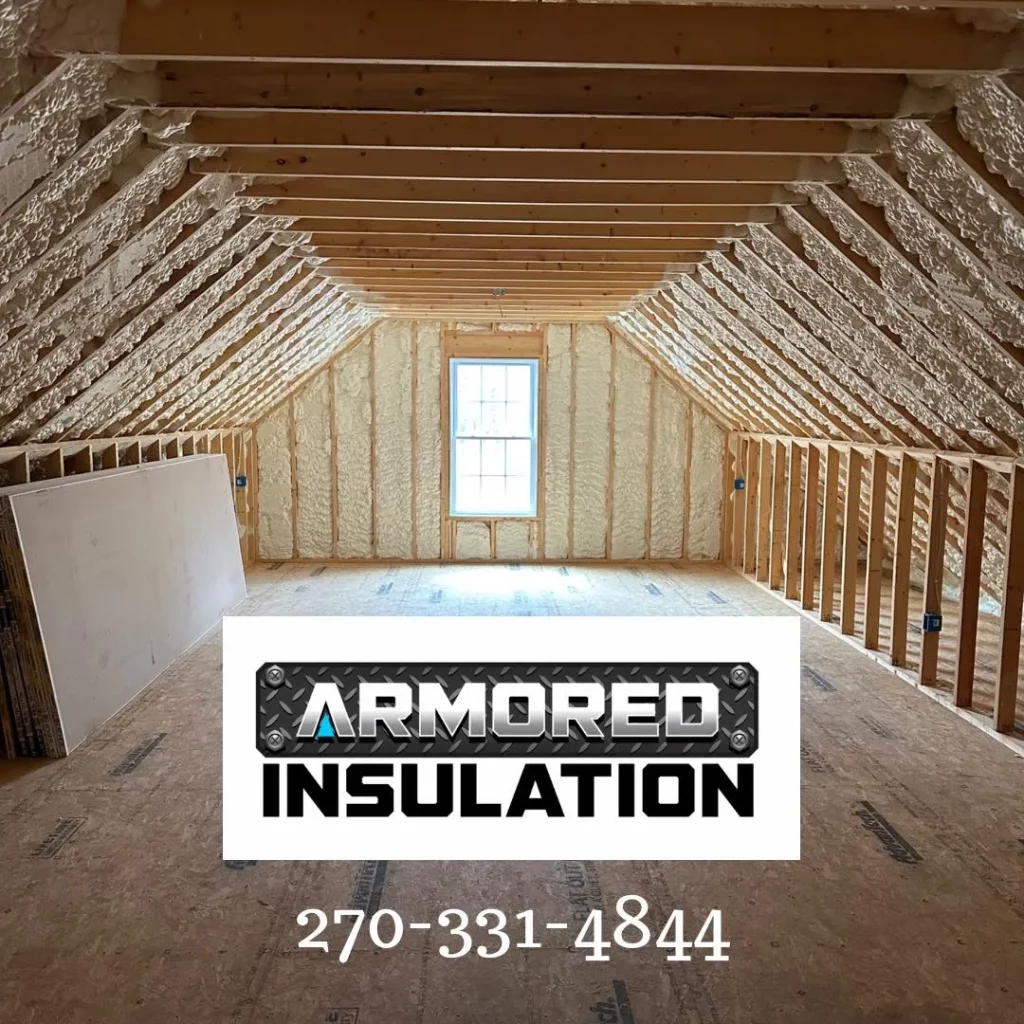
Yes, spray foam insulation is an excellent choice for most workshops and metal buildings. Its ability to create a complete air and moisture barrier makes it uniquely suited to solve the biggest challenges these structures face: condensation, temperature swings, and air leakage. Unlike traditional insulation like fiberglass batts, which can trap moisture against the metal panels, spray foam adheres directly to the surface. This eliminates the gaps where condensation, often called “building sweat,” forms.
Here, we’ll look at how spray foam insulation works in metal structures by outlining its specific benefits, potential drawbacks, and the factors you need to consider. This guidance comes from extensive field experience insulating hundreds of workshops and steel buildings, so you can make a sound decision for your property.
Metal buildings and workshops have insulation requirements that differ from standard wood-frame construction. The properties of steel create specific environmental challenges inside the structure that the right insulation must address.
First, metal is a highly conductive material. It transfers heat and cold very efficiently, meaning an uninsulated building will be extremely hot in the summer and cold in the winter. Second, these buildings are prone to condensation. When warm, humid air inside the building comes into contact with the cooler surface of the metal panels, the moisture in the air condenses into water droplets. This can lead to rust, mold, and damage to stored equipment or materials. Finally, the large, open spaces and metal panels can amplify noise from rain, wind, or work activities.
Spray polyurethane foam (SPF) comes in two main types: open-cell and closed-cell. While both insulate, they have different properties that make one a clear winner for metal building applications. Closed-cell spray foam is almost always the recommended option for insulating steel structures. Its dense structure makes it rigid and waterproof, acting as a true vapor barrier that stops moisture from reaching the metal panels.
Open-cell foam is softer and lighter, like a sponge. It has a lower R-value per inch and is vapor-permeable, meaning water vapor can pass through it. This makes it a poor choice for direct application to metal, as it won’t stop condensation.
Here’s a direct comparison of how they stack up for this specific use:
| Feature | Closed-Cell Spray Foam | Open-Cell Spray Foam |
|---|---|---|
| R-Value per Inch | R-6.5 to R-7 | R-3.5 to R-4 |
| Vapor Permeability | Very Low (acts as a vapor barrier) | High (is not a vapor barrier) |
| Structural Rigidity | High (adds strength) | Low (flexible and soft) |
| Water Resistance | Resists bulk water | Absorbs water |
| Typical Application | Direct to metal panels | Wood-framed walls, attics |
For these reasons, closed-cell foam’s ability to provide a high R-value, block moisture, and add a degree of structural strength makes it the superior material for workshops and metal buildings.
Applying closed-cell spray foam in a workshop or metal building delivers several key benefits that go beyond simple temperature control.
This is the most significant advantage. By creating a seamless, monolithic layer bonded directly to the metal, spray foam prevents warm, moist interior air from ever touching the cold exterior panels. This stops condensation before it can start, protecting the building itself from rust and the contents from water damage.
The U.S. Department of Energy’s ENERGY STAR program highlights that sealing air leaks can save a significant amount on energy bills. Spray foam is both an insulator and an air barrier. It seals every crack and crevice, stopping drafts and creating a stable interior climate. This drastically reduces the workload on your heating and cooling systems, leading to lower energy consumption year-round.
Bonus Tip: In regions with hot, humid summers, applying at least two inches of closed-cell spray foam can effectively stop radiant heat transfer, keeping the interior noticeably cooler and reducing air conditioning costs.
The rigid nature of closed-cell foam provides an extra layer of strength to the building’s metal shell. When applied, the foam’s adhesive properties and dense structure can help reduce panel flex from high winds or heavy snow loads, making the entire structure feel more solid.
Workshops can be noisy environments. Spray foam insulation absorbs sound waves, reducing noise from machinery inside and weather outside. The difference during a heavy rainstorm in a foam-insulated building compared to an uninsulated one is remarkable.
While spray foam is a high-performance solution, it requires careful planning. Here are a few things to think about before you commit.
Bonus Tip: Before getting a quote, make sure your building is clean and accessible. The installer will need clear access to all surfaces to be sprayed, and any oil or dirt on the metal panels must be cleaned off to ensure proper adhesion.

Closed-cell spray foam is the definitive choice. Its low vapor permeability, high R-value, and structural rigidity are perfectly suited to manage the moisture and thermal challenges unique to metal construction.
Absolutely. Spray foam is ideal for retrofitting existing structures. The application process is relatively quick, and because it conforms to any shape, it works well around existing framing, wiring, and plumbing.
The ideal thickness depends on your climate and goals. For condensation control alone, 1 to 1.5 inches is often enough. For full temperature regulation in a conditioned workshop, 2 to 3 inches is more common. An installer can perform a calculation based on your local climate and desired interior temperature.
It helps prevent future rust. By creating a moisture barrier, closed-cell spray foam stops the condensation that causes rust to form. It will also seal off existing surface rust from the oxygen and moisture needed for it to spread. It does not, however, repair existing structural rust.
In an unoccupied storage building, it may be possible to leave it exposed. But in a workshop or any building with regular human occupancy, a thermal or ignition barrier is almost always required by code. Drywall, plywood, or a special intumescent coating are common options.
Spray foam will seal small pinhole leaks and gaps around fasteners, but it is not a roofing product. It should not be relied upon to fix a failing roof. Any significant leaks in the roof panels or seams should be properly repaired before insulation is installed.
For most workshops and metal buildings, closed-cell spray foam is the most effective insulation available. It directly solves the key problems of condensation and heat transfer while providing the added benefits of air sealing and sound dampening. While the upfront cost is a consideration, its long-term performance protects your investment and creates a more comfortable, efficient space. Ultimately, if your goals are to eliminate condensation, maximize energy efficiency, and strengthen your structure, spray foam is the clear solution.
Choosing the right insulation requires careful planning and professional expertise. To discuss the specific needs of your workshop or metal building, contact Armored Insulation for a straightforward assessment. Reach out to the team by phone at (270) 331-4844 or by email at [email protected] to ensure your project is done right from the start.